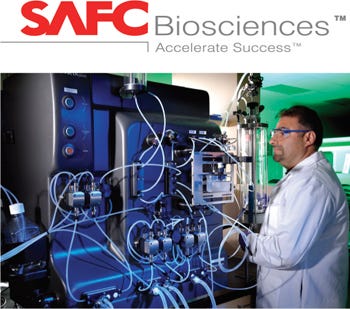Voices of Biotech
Podcast: MilliporeSigma says education vital to creating unbreakable chain for sustainability
MilliporeSigma discusses the importance of people, education, and the benefits of embracing discomfort to bolster sustainability efforts.
July 1, 2009
Interruptions in bioproduction pose serious setbacks for biopharmaceutical companies. Shipping delays, performance variability, quality unknowns, and regulatory issues can delay time to market and ultimately depress a producer’s financial results. Unforeseen variability in process parameters has led the US Food and Drug Administration to insist that biopharmaceutical manufacturers find ways to ensure batch quality of a drug product during manufacture without relying solely on finished product characterization. This challenge is daunting, considering the large number of raw materials required for production and the complexities of cell culture systems.
To meet the industry’s requirement for enhanced raw material characterization, SAFC Biosciences® has developed innovative analytical and assay methods that provide customers with biopharmaceutical raw material standards that ensure process development control, production quality, and supply chain security.
Defining Undefined Components: Hydrolysates
Hydrolysates top many biopharmaceutical companies’ lists of components requiring greater definition. The capacity for hydrolysates to exert substantial positive impact on cell growth and/or protein production is well documented, but by nature an undefined and variable component still inhibits the pursuit of highly controlled and defined pharmaceutical production processes. The challenge for most organizations is that hydrolysates have become entrenched in their platform processes, creating cell lines and applications that require unique performance features that can only be supplied by hydrolysates.
If defining the key compounds within hydrolysates is the answer for defined processes, two major obstacles must be overcome. First, hydrolysates contain literally thousands of components and must be simplified before analytical interrogation. Second, a cell culture assay system must be developed that is sensitive enough to tease-apart the important factors. Deciphering this hydrolysate puzzle enables a raw material supplier to provide a solution that ensures regulatory and operational requirements while reducing risks associated with supply variability.
SAFC Biosciences’ solution to the hydrolysate puzzle is EX-CELL® CD Hydrolysate Fusion, a chemically defined, animal component free, and synthetically produced supplement that is the first generation of supplier facilitated raw material characterization. EX-CELL® CD Hydrolysate Fusion is available in 20X liquid (catalog no. 14700C) or dry powder (catalog no. 24700C). SAFC Biosciences’ assay system and sophisticated analytical techniques achieve a better definition for consistency of hydrolysate performance.

Process Quality Through Antifoam Delivery
Many culture media contain proteins and other components with surfactant properties. Because suspension culture growth media must be agitated to aerate and suspend cells, foam is a nearly inescapable complication. Foaming forms a formidable barrier to efficient gas exchange and is known to prevent proper cell and supplement circulation, ultimately sickening a culture. It denatures proteins in solution, an unwelcome factor in extracellular fusion protein expression systems. Foam also interferes with decanting, filtration, and centrifugation — nearly any fluid-handling operation performed while isolating product from the culture.
One approach to managing this hazard is delivery of a controlled silicone-based antifoam polymer that works at very low concentrations to suppress foaming in aqueous media. SAFC Biosciences provides a bulk disposable and gamma-irradiated EX-CELL® Antifoam solution (catalog no. 59920C) designed to control foaming while ensuring sterility and process ease typically associated with the use of culture medium in bioreactors. By optimizing the formulation, quantitative assaying, and an understanding of the nonspecific binding of simethicone, SAFC Biosciences is the only company capable of reporting the actual percent simethicone dilution of the finished material. As a result, you can understand the impact of varying antifoam concentrations and ensure a controlled production process.
You May Also Like